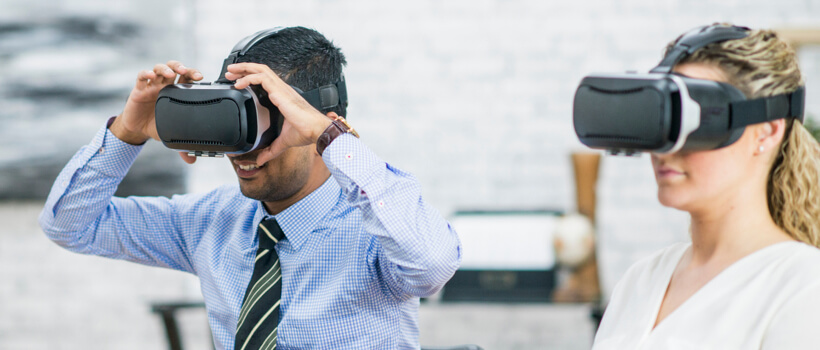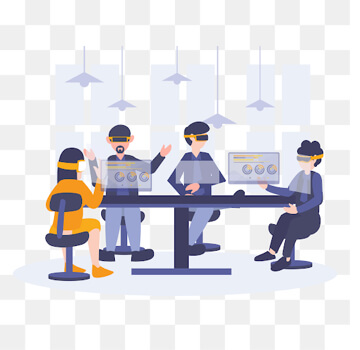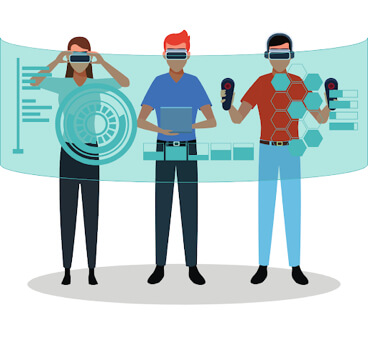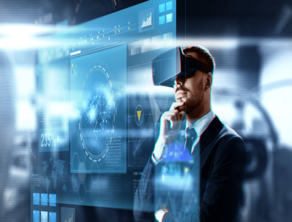Future of VR in ‘Virtualized’ Workplaces

Table of contents
- Introduction
- Four ways in which VR has the potential to impact the workplace:
- Examples of Future in VR
- Conclusion
Introduction
For many, virtual reality (VR) likely summons images of game-obsessed teenagers wearing goggles and admiring the feeling of riding a rollercoaster or gliding through space from the comfort of their couch. However, the most potent future virtual reality applications will go beyond pure entertainment, drastically changing how people think about their work and workplace.

It started with Zoom/Oculus, then came Webex, and then Microsoft began their Microsoft Mesh, and now; Slack. Four giants collaborated to join the Metaverse, a newly-coined phrase used to represent the concept of a forthcoming variant of the internet.
Facebook changed the direction of the virtual reality industry in 2014 through a $2 billion acquisition deal with Oculus VR. Before this deal, the notion was that virtual reality would only fit in the world of video games. The value showed Facebook’s confidence in the technology and established that the future of VR is promising: Within two years, the total amount invested and the number of venture capital contracts tripled. While the widespread adoption of virtual reality is still distant, many companies have already incorporated the technology into their business practices to create innovative, sustainable workplaces.
According to a report by PWC, Virtual reality (VR) and augmented reality (AR) can strengthen the global economy by nearly $2 trillion by 2030. These technologies will soon be familiar in the workplace.
Even with the onset of remote work due to the pandemic, the workplace has transformed as new technologies have pervaded work. One of the technologies that stood out was X-Reality.
Extended Reality (X-Reality) defines the merge of digital technologies with the real world.
The “X” in X-Reality consists of four technologies:
Augmented, Virtual, Mixed and Assisted Reality.
VR in X-Reality helps make a user’s interaction with the digital world more intuitive and seamless. The new human-technology interaction can add value for companies while gaining a competitive advantage. We can use VR for work meetings, training, and customer service experience in the workplace.

A report by PWC predicts that by 2030, nearly 23 million jobs will use AR and VR. According to ARtillery Intelligence, VR usage in businesses is expected to grow to $4.26 billion by 2023.
In 2021, Facebook’s VR headset brand Horizon, an Oculus for business platform, was released. This platform will assist workers in interacting digitally in a more immersive form without the need to go to any location, thus supporting the hybrid work model. Facebook Horizon will let its users share and build collaborative online worlds to work on projects, hang out, or play games.
Increased Connection and Collaboration Virtual reality allows individuals to unite regardless of physical distance. However, VR users can feel like they are inhibiting the same space, which results in good collaboration. VR provides a medium for users to view and manipulate data together in real-time. While some companies prefer installing mixed-reality rooms to execute VR meetings and collaborative work sessions, others distribute VR headsets that can be used in the office or remotely. This technology is readily available and intuitive, helping people collaborate and connect.
Four ways in which VR has the potential to impact the workplace:
- New HR Practices
Human resources will transform drastically with the effortless global connectivity that VR provides. Corporates can use VR in a variety of interactive HR workshops. With access to workers worldwide, hiring techniques will grow to recruit top talent. As part of the interview process, forthcoming employees will have the opportunity to virtually shadow their potential standing to understand the day-to-day responsibilities better.
- Upgraded Training Methods
Putting individuals into a fully immersive real-life scenario forms the perfect training tool. VR training is beneficial in high-risk situations, allowing employees to gain experience safely. The armed forces and NASA use VR training to minimize risk and costs. Walmart has also taken advantage of the technology, using simulations to train employees for the Black Friday rush. Regardless of the industry, VR offers an engaging, educational experience.
- More Efficient Product Development
Within a computer-generated environment, product development will evolve more efficiently than ever. Organizations can use Virtual reality to test products in different scenarios, eliminating the necessity for expensive physical prototypes. Modifications can be made virtually and immediately during trials, allowing the final product to be refined faster. From spacecraft to cars, large-scale manufacturers are already using VR to test everything:
Ford uses the Oculus Rift, a popular VR headset, to create and refine virtual prototypes generally used for gaming.
- Creative Marketing Practices
Virtual reality will redefine the old-fashioned test drive. From cars to vacations, VR allows customers to test every product and experience before purchasing. When customers are keen to make a purchase, they can do it virtually. VR’s immersive experience is impactful, creating a personal connection between consumers and brands and influencing purchasing decisions.
For most, virtual reality (VR) is an alien concept, a technology perhaps limited to gaming. However, the industry is about to grow from $27.9 billion in 2025, and due to the pandemic, there is a rise in VR products and services.
Could VR move from a futuristic concept to reality for remote employees? Yes, it will, as Experts anticipate that nearly 23.5 million jobs worldwide will be utilizing augmented or virtual reality by 2030.
Facebook disclosed its plans to invest over ten billion in funds to help create significant progress toward an unexplored (iteration) of the internet.
It will consist of constantly shared, 3D virtual spaces connected into a (perceived) virtual universe-like (metaverse) technological improvements that could soon remove worker hurdles. It will also unfold many benefits related to training learning that boosts safety awareness, employee engagement, and mitigating expenses related to workplace training.
Examples of Future in VR
- Check out Zukerburg’s vision for the Metaverse.
With Metaverse, future employees will likely have more immersive work experiences for remote workers. Companies should adopt VR technologies that help in viable future-leaning workplace collaboration. The existing Metaverse is finite, but it looks like it will transform the internet. Facebook has invested a massive amount of funds into the future of the internet space, where you can interact with coworkers, collaborate, and co-create.
- Zoom-Oculus Workplace AR/VR
Zoom and Oculus, a Facebook/Meta company, joined Zoomtopia in 2021. The duo squad revealed the launch of the new app, which expands virtual collaboration by incorporating VR users and video chat participants, leading to a collaboration market.
The duo aims to let users access Zoom meetings and Zoom whiteboards within virtual workroom environments, leveraging Horizon Workrooms, available on Facebook’s Oculus Quest headset. It is set for availability in early 2022.
- Webex Hologram
Comprehending the power of augmented reality (AR), Cisco wants to bridge the gap between virtual and in-person collaboration. Cisco showed the world its new forward-thinking AR/VR tech application, the Webex Hologram.
The platform integrates the rich features of Webex meetings and calling with the functionality of immersive 3D holograms.
It plans to tackle the problem with its photorealistic, real-time, holographic experience for any method that includes remote or many remote employees. Taking a cue from its research, which suggests in Cisco’s Hybrid Work Index – 64% of employees said that they would resign their job if they did not have the option to work remotely.
Conclusion
With technological origins in the early 20th century, Virtual reality is not new, yet its applications are still in infancy. We are only at the surface of virtual reality, and its most significant applications have likely not been developed yet. While 64% have stated that there is a sort of technological contest between AR and VR, implying only one will emerge as dominant, it appears probably that both will play roles in navigating the future of enterprise and entertainment.
Historically, virtual reality has always wedded entertainment with practical use. Today’s virtual reality applications and future ones will continue to lead the trend. The gaming industry will undoubtedly profit from the advancement of VR. Still, it will come as a bit of a surprise to see virtual reality play a game-changing role in how businesses – and industries – work.
Tags: Virtual Reality, VR
![Blog-[x]cube LABS](https://d6fiz9tmzg8gn.cloudfront.net/wp-content/uploads/2016/06/blog_banner.jpg)






